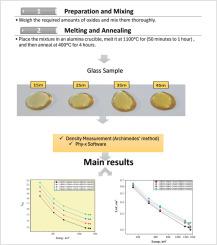Eco-optimized PbO2CaO-B2O3 glasses for chargeless radiation shielding: An integrated experimental and theoretical investigation on the role of BaO and Sm2O3 doping
IF 4.3
Q2 CHEMISTRY, PHYSICAL
引用次数: 0
Abstract
The pursuit of efficient, stable, lead-compatible, and transparent radiation-shielding materials is vital for chargeless radiation, such as gamma and neutron shielding applications. In this study, a new series of BaO (19–25 mol %) and Sm2O3 (1–4 mol %) doped 11PbO2-xBaO-10CaO-(79-x-y)B2O3-ySm2O3 glasses were synthesized via the conventional melt-quenching technique. X-ray diffraction (XRD) analysis confirmed the amorphous nature and ensured its structural uniformity of the samples. Density measurements showed a significant increase from 3.953 to 4.388 g/cm3 with increasing BaO and Sm2O3 content. The gamma radiation shielding performance was experimentally determined using a NaI(Tl) detector with gamma sources, including 133Ba, 22Na, 137Cs, and 60Co isotopes. Theoretical evaluations of radiation shielding parameters, including the mass attenuation coefficient, linear attenuation coefficient, half-value layer, tenth value layer, mean free path, and effective atomic number, were performed using the Phy-X/PSD database. At 356 keV, the LAC increased from 0.587 cm-1 for the sample containing 1 mol % Sm2O3 to 0.650 cm-1 for the sample containing 4 mol % Sm2O3. The neutron shielding effectiveness was assessed using the effective removal cross-section (ΣR) of the material. The MFP at 356 keV decreased from 1.649 cm in the base glass (19BaO + 1Sm2O3) to 1.458 cm (25BaO + 4Sm2O3) in the optimized composition. The combined presence of BaO and Sm2O3 produced a synergistic effect, making these glasses promising candidates for advanced radiation-shielding applications.

生态优化的PbO2CaO-B2O3无电荷辐射屏蔽玻璃:BaO和Sm2O3掺杂作用的综合实验和理论研究
追求高效,稳定,铅兼容和透明的辐射屏蔽材料对于无电荷辐射至关重要,例如伽马和中子屏蔽应用。本研究采用传统的熔淬技术合成了BaO (19-25 mol %)和Sm2O3 (1-4 mol %)掺杂的11PbO2-xBaO-10CaO-(79-x-y)B2O3-ySm2O3玻璃。x射线衍射(XRD)分析证实了样品的非晶态性质,保证了样品的结构均匀性。随着BaO和Sm2O3含量的增加,密度从3.953 g/cm3显著增加到4.388 g/cm3。采用含有133Ba、22Na、137Cs和60Co同位素的NaI(Tl)探测器,实验测定了其屏蔽γ辐射的性能。利用Phy-X/PSD数据库对辐射屏蔽参数进行了理论评价,包括质量衰减系数、线性衰减系数、半值层、十值层、平均自由程和有效原子序数。在356 keV时,LAC从含有1 mol % Sm2O3的样品的0.587 cm-1增加到含有4 mol % Sm2O3的样品的0.650 cm-1。利用材料的有效去除截面(ΣR)评估中子屏蔽效果。在356 keV下,MFP从基片玻璃(19BaO + 1Sm2O3)的1.649 cm下降到优化后的25BaO + 4Sm2O3的1.458 cm。BaO和Sm2O3的结合产生了协同效应,使这些玻璃成为先进辐射屏蔽应用的有希望的候选者。
本文章由计算机程序翻译,如有差异,请以英文原文为准。
求助全文
约1分钟内获得全文
求助全文
来源期刊

Chemical Physics Impact
Materials Science-Materials Science (miscellaneous)
CiteScore
2.60
自引率
0.00%
发文量
65
审稿时长
46 days
 求助内容:
求助内容: 应助结果提醒方式:
应助结果提醒方式:


